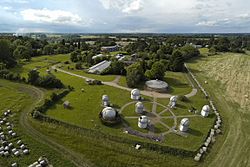Bayfordbury Observatory facts for kids
Quick facts for kids Bayfordbury Observatory |
|||||||||||||||||||
|---|---|---|---|---|---|---|---|---|---|---|---|---|---|---|---|---|---|---|---|

Optical domes of the observatory
|
|||||||||||||||||||
| Organization | University of Hertfordshire | ||||||||||||||||||
| Code | J33 | ||||||||||||||||||
| Location | Hertfordshire, United Kingdom | ||||||||||||||||||
|
Coordinates
|
51°46′30″N 00°05′40″W / 51.77500°N 0.09444°W
|
||||||||||||||||||
| Altitude | 66 metres (217 ft) | ||||||||||||||||||
| Established | 1969 | ||||||||||||||||||
| Website Bayfordbury Observatory |
|||||||||||||||||||
|
|||||||||||||||||||
Bayfordbury Observatory is a special place where students and scientists from the University of Hertfordshire study space and the Earth's atmosphere. It is one of the biggest observatories in the United Kingdom used for teaching. The observatory is located in the quiet countryside of Bayfordbury, Hertfordshire. It is about 6 miles from the main university campus in Hatfield. The first telescope was built here in 1969. Since then, it has been used to teach university students. It also helps staff and students do research. Plus, it hosts fun events for the public.
Contents
History of the Observatory
The first telescope was set up at Bayfordbury in 1969. This was just one year after the university (then called Hatfield Polytechnic) started teaching astronomy. This first telescope was a 16-inch Newtonian/Cassegrain type.
In 1970, a famous astronomer named Richard van der Riet Woolley officially opened the observatory. He was the Astronomer Royal at the time. Over the years, more telescopes were added. The astronomy department also grew bigger.
In 2000, the observatory celebrated its 30th birthday. It got a big upgrade then. Three new domes were built for telescopes. A large 4.5-meter radio telescope was also added. A special control building was built too. It was named after Sir Patrick Moore, a very well-known astronomer. From this building, scientists can control the telescopes with computers. They can also study the pictures they take.
Exploring Space with Telescopes
The observatory has seven main optical telescopes. These telescopes look at light, just like our eyes do. The biggest one is the 20-inch J.C.D Marsh Cassegrain Telescope. Five other telescopes are 16-inch robotic Meade LX200s. They can be controlled by computers. There is also a 14-inch Meade LX200.
These telescopes have special cameras called CCD cameras. They also have spectrographs, which break light into colors. This helps scientists learn what things in space are made of. Some smaller telescopes are attached to the main ones. They help guide the main telescopes. Some are used for wide views or to look at the Sun.
Listening to Space with Radio Telescopes
Besides optical telescopes, Bayfordbury also has radio astronomy tools. These listen to radio waves from space. The largest one is the 4.5-meter R.W. Forrest telescope. It can detect radio waves from hydrogen gas in space. Hydrogen is the most common element in the universe. Three more 3-meter radio telescopes will soon work together. They will form a large interferometer. This lets them act like one giant telescope.
The Planetarium and Sky Cameras
A science building nearby has a planetarium. This is a special room where stars and planets are projected onto a dome. It's used during open evenings and for group visits. The roof of this building has other cool equipment. There's a Sky Quality Meter to measure light pollution. A coelostat helps observe the Sun. There are also day and night-time all-sky cameras. These cameras take pictures of the whole sky. The university operates six of these cameras across the UK.
The university often holds public events. They have monthly open evenings from October to March. School classes and community groups can also visit.
Studying Earth's Atmosphere
Since 2010, the observatory has also been used to study Earth's atmosphere. This is called remote sensing. It means studying something from a distance.
One of the old telescope domes now holds special equipment. It has a LIDAR/ceilometer. This uses lasers to measure clouds and air. There's also a very sensitive sun polarimeter. This measures how sunlight is scattered by particles in the air. An infrared pyrometer detects cirrus clouds. These are high, thin clouds. Soon, an infrared spectropolarimeter will be added.
The roof of the nearby science building also has more instruments. It has an automatic sun photometer and lunar photometer. These are part of NASA's AERONET network. There's also a scanning infrared radiometer. A pyrgeometer and pyranometer measure different types of radiation. And, of course, the day and night-time all-sky cameras are there too.
Images for kids






